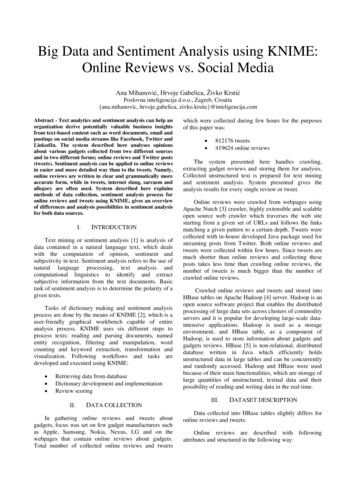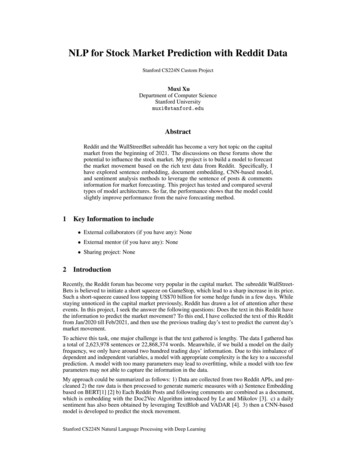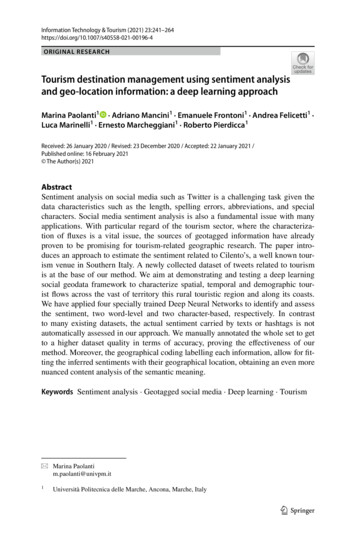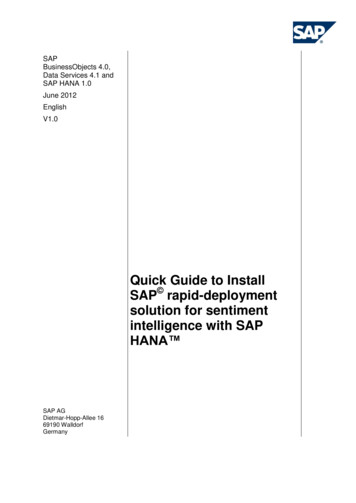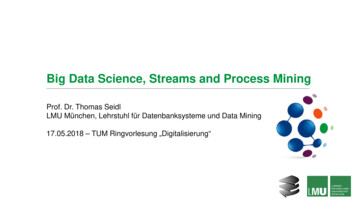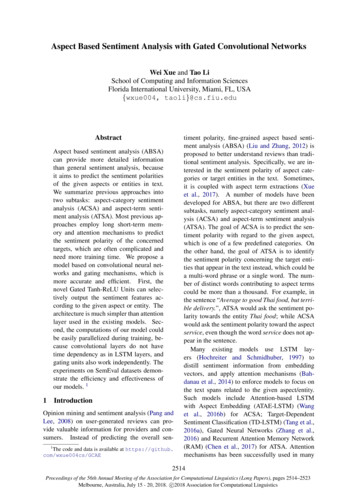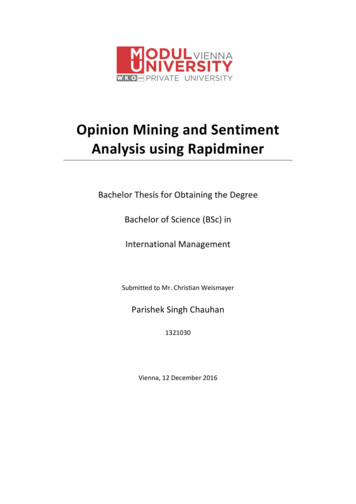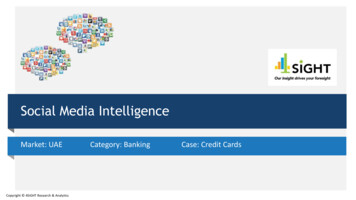
Transcription
Alec Go (alecmgo@stanford.edu)Lei Huang (leirocky@stanford.edu)Richa Bhayani (richab86@stanford.edu)CS224N - Final Project ReportJune 6, 2009, 5:00PM (3 Late Days)Twitter Sentiment AnalysisIntroductionTwitter is a popular microblogging service where users create status messages (called"tweets"). These tweets sometimes express opinions about different topics.The purpose of this project is to build an algorithm that can accurately classify Twittermessages as positive or negative, with respect to a query term. Our hypothesis is that wecan obtain high accuracy on classifying sentiment in Twitter messages using machinelearning techniques.Generally, this type of sentiment analysis is useful for consumers who are trying to researcha product or service, or marketers researching public opinion of their company.Defining SentimentFor the purposes of our research, we define sentiment to be "a personal positive or negativefeeling." Here are some s: Jquery is my newbest friend.NeutralSan Franciscoschuyler: just landed at SanFranciscoNegativeexamjvici0us: History examstudying ugh.For tweets that were not clearcut, we use the following litmus test: If the tweet could everappear as a newspaper headline or as a sentence in Wikipedia, then it belongs in the neutralclass. For example, the following tweet would be marked as neutral because it is fact froma newspaper headline, even though it projects an overall negative feeling about GM:ThomasQuinlin: RT @Finance Info Bankruptcy filing could put GM on road to profits (AP)http://cli.gs/9ua6Sb #FinanceRelated WorkThere have been many papers written on sentiment analysis for the domain of blogs andproduct reviews. (Pang and Lee 2008) gives a survey of sentiment analysis. Researchershave also analyzed the brand impact of microblogging (Jansen). We could not find anypapers that analyzes machine learning techniques in the specific domain of microblogs,probably because the popularity of Twitter is very recent.
Overall, text classification using machine learning is a well studied field (Manning andSchuetze 1999). (Pang and Lee 2002) researched the effects of various machine learningtechniques (Naive Bayes (NB), Maximum Entropy (ME), and Support Vector Machines (SVM)in the specific domain of movie reviews. They were able to achieve an accuracy of 82.9%using SVM and a unigram model.Researchers have also worked on detecting sentiment in text. (Turney 2002) presents asimple algorithm, called semantic orientation, for detecting sentiment. (Pang and Lee 2004)present a hierarchical scheme in which text is first classified as containing sentiment, andthen classified as positive or negative.Work (Read, 2005) has been done in using emoticons as labels for positive and sentiment.This is very relevant to Twitter because many users have emoticons in their tweets.Twitter messages have many unique attributes, which differentiates our research fromprevious research:1. Length. The maximum length of a Twitter message is 140 characters. From our trainingset, we calculated that the average length of a tweet is 14 words, and the average length ofa sentence is 78 characters. This is very different from the domains of previous research,which was mostly focused on reviews which consisted of multiple sentences.2. Available data. Another difference is the sheer magnitude of data. In (Pang and Lee2002), the corpus size 2053. With the Twitter API, it is much easier to collect millions oftweets for training.3. Language model. Twitter users post messages from many different mediums, includingtheir cell phones. The frequency of misspellings and slang in tweets is much higher thanother domains.ProcedureData CollectionThere are not any existing data sets of Twitter sentiment messages. We collected our ownset of data. For the training data, we collected messages that contained the emoticons :)and :( via the Twitter API.The test data was manually. A set of 75 negative tweets and 108 positive tweets weremanually marked. A web interface tool was built to aid in the manual classification task.See Appendix A for more details about the data.ClassifiersSeveral different classifiers were used. A Naive Bayes classifier was built from scratch.Third-party libraries were used for Maximum Entropy and Support Vector Machines. Thefollowing table summarizes the results.
Table 1. Accuracy results from various classifiersTraining size also has an effect on performance. Figure 1 shows the effect of training sizeon accuracy.Figure 1. Effect of training size on different classifiers.Naive BayesNaive Bayes is a simple model for classification. It is simple and works well on textcategoration. We adopt multinomial Naive Bayes in our project. It assumes each feature isconditional independent to other features given the class. That is,where c is a specific class and t is text we want to classify. P(c) and P(t) is the priorprobabilities of this class and this text. And P(t c) is the probability the text appears given
this class. In our case, the value of class c might be POSITIVE or NEGATIVE, and t is just asentence.The goal is choosing value of c to maximize P(c t):Where P(wi c) is the probability of the ith feature in text t appears given class c. We needto train parameters of P(c) and P(wi c). It is simple for getting these parameters in NaiveBayes model. They are just maximum likelihood estimation (MLE) of each one. Whenmaking prediction to a new sentence t, we calculate the log likelihood log P(c) ilogP(wi c) of different classes, and take the class with highest log likelihood as prediction.In practice, it needs smoothing to avoid zero probabilities. Otherwise, the likelihood will be0 if there is an unseen word when it making prediction. We simply use add-1 smoothing inour project and it works well.Feature selectionFor unigram feature, there are usually 260,000 different features. This is a very largenumber. It makes model higher variance. (Since more complicated model has highervariance). So it will need much more training data to avoid overfitting. Our training setcontains hundreds of thousands sentences. But it is still a large number of features for ourtraining set. It is helpful if we discard some useless features. We try 3 different featureselection algorithms.Frequency-based feature selectionThis is the simplest way to do feature selection. We just pick features (unigram words in ourcase) for each class with high frequency occurrence in this class. In practice, if the numberof occurrences of a feature is larger than some threshold (3 or 100 in our experiments), thisfeature is a good one for that class. As we seen in the result table, this simply algorithmincreases about 0.03 of accuracy.Mutual InformationThe idea of mutual information is, for each class C and each feature F, there is a score tomeasure how much F could contribute to making correct decision on class C. The formula ofMI score is,In practice, we also use add-1 smoothing for each Count(C ec, F ef) to avoid divided byzero. The code is below.double n polarityAndFeatureCount.totalCount() 4;for(String feature : featureCount.keySet()) {for(int polarity : polarityCount.keySet()) {double n11 polarityAndFeatureCount.getCount(polarity, feature) 1;double n01 polarityCount.getCount(polarity) -
polarityAndFeatureCount.getCount(polarity, feature) 1;double n10 featureCount.getCount(feature) polarityAndFeatureCount.getCount(polarity, feature) 1;double n00 n - (n11 n01 n10);doubledoubledoubledoublen1dotn0dotndot1ndot0 n11n n11n -double miScore n10;n1dot; ))ndot0))ndot0));mi.setCount(polarity, feature, miScore);}}After calculating MI score, only top k features with highest scores will be picked for featureset to test. We can see that if k is small, the model is too simple that data is underfitting.But if k is large, the model is too complicated that data is overfitting. The best number offeatures in our unigram case is about 40,000. As k grow up to 20,000, the accuracy and Fscore are also grow up quickly. This is because in this area, the model is high bias. So it ishelpful to add features to avoid underfitting data. When the number is larger than 100,000,the accuracy and F score decrease gradually. Since the large number of features makesmodel so complicated that there are not enough training sentence to avoid overfitting.
Figure 2 - Mutual Information - Number of Features vs. AccuracyΧ2Feature selection2The idea of Χ Feature selection is similar as mutual information. For each feature and class,there is also a score to measure if the feature and the class are independent to each other.2It uses Χ test, which is a statistic method to check if two events are independent. It2assumes the feature and class are independent and calculates Χ value. The large scoreimplies they are not independent. For example, the critical value of 0.001 is 10.83. Thismeans, if they are independent to each other, then the probability this score larger than10.83 is only 0.001. Alternatively, if the score is larger than 10.83, then it is unlikely thefeature and the class independent. The larger the score is, the higher dependency they2have. So we want keep features for each classes with highest Χ scores. The formula of2Χ score is,where N is the total number of training sentences. N 11 is the number the co-occurrence ofthe feature F and the class C. N10 is the number of sentences contains the feature F but isnot in class C. N01 is the number of sentences in class C but doesn’t contain feature F. N 00is the number of sentences not in C and doesn’t contain feature F. We implement it similaras mutual information, except using this different formula.
2The performance of Χ Feature selection is very similar as mutual information in our project.Both these two method could increase both accuracy and F score by 0.05.Table 2. Results from various feature selection testsMaximum EntropyThe idea behind MaxEnt classifiers is that we should prefer the most uniform models thatsatisfy any given constraint. MaxEnt models are feature based models. We use thesefeatures to find a distribution over the different classes using logistic regression. Theprobability of a particular data point belonging to a particular class is calculated asfollows:Where, c is the class, d is the data point we are looking at, and λ is a weight vector.MaxEnt makes no independence assumptions for its features, unlike Naïve Bayes. Thismeans we can add features like bigrams and phrases to MaxEnt without worrying aboutfeature overlapping.We tried using two packages for the MaxEnt implementation: the Stanford Classifier and theOpenNLP package.PerformanceThe Stanford Classifier package gave bad results for the default parameter settings. Overdifferent training sizes (Figure 1) it did improve a bit, but was a lot worse than the otherclassifiers. We changed the smoothing constants, but it never got very close to the NBclassifier in terms of accuracy. As shown in Figure 3, different sigma (smoothing) values didnot contribute much to higher accuracy.
Figure 3. Sigma (the smoothing parameter) vs accuracyAfter testing for different smoothing values and trying different functions in place ofConjugateDescent, we decided to try OpenNLP’s MaxEnt classifier since time was runningshort.MaxEnt from OpenNLP did perform considerably better. As one can see from Figure 1,MaxEnt performs similar to how the NB performs. Since it doesn’t significantly improveperformance and takes very long to train and test, we decided to pursue NB for some otherexperiments.Support Vector MachinesSupport Vector Machines were also explored using Weka software. We tested SVM with aunigram feature extractor, and achieved only 73.913% accuracy. We used a linear kernel.SVMs have many parameters. We believe that performance can be improved here bytrying different parameters and kernels.Feature Extractors1. UnigramBuilding the unigram model took special care because the Twitter language model is verydifferent from other domains from past research. The unigram feature extractor addressedthe following issues:
a. Tweets contain very casual language. For example, you can search "hungry" with arandom number of u's in the middle of the word on http://search.twitter.com to understandthis. Here is an example sampling:huuuungry: 17 results in the last dayhuuuuuuungry: 4 results in the last dayhuuuuuuuuuungry: 1 result in the last dayBesides showing that people are hungry, this emphasizes the casual nature of Twitter andthe disregard for correct spelling.b. Usage of links. Users very often include links in their tweets. An equivalence class wascreated for all URLs. That is, a URL like "http://tinyurl.com/cvvg9a" was converted to thesymbol "URL."c. Usernames. Users often include usernames in their tweets, in order to address messagesto particular users. A de facto standard is to include the @ symbol before the username(e.g. @alecmgo). An equivalence class was made for all words that started with the @symbol.d. Removing the query term. Query terms were stripped out from Tweets, to avoid havingthe query term affect the classification.2. BigramsThe reason we experimented with bigrams was we wanted to smooth out instances like 'notgood' or 'not bad'. When negation as an explicit feature didn't help, we thought ofexperimenting with bigrams.However, they happened to be too sparse in the data and the overall accuracy dropped inthe case of both NB and MaxEnt. Even collapsing the individual words to equivalence classesdid not help.Bigrams however happened to be a very sparse feature which can be seen in the outputswith a lot of probabilities reported as 0.5:0.5.For context: @stellargirl I loooooooovvvvvveee my Kindle2. Not that the DX is cool, but the2 is fantastic in its own right.Positive[0.5000] Negative[0.5000]3. Negate as a featuresUsing the Stanford Classifier and the base SVM classifiers we observed that identifying NEGclass seemed to be tougher than the POS class, merely by looking at the precision, recalland F1 measures for these classes. This is why we decided to add NEGATE as a specificfeature which is added when “not” or ‘n’t” are observed in the dataset. However we onlyobserved a increase in overall accuracy in the order of 2% in the Stanford Classifier andwhen used in conjunction with some of the other features, it brought the overall accuracydown and so we removed it.Overlapping features could get the NB accuracy down, so we were not very concerned aboutthe drop with NB. However it didn't provide any drastic change with OpenNLP either.4. Part of Speech (POS) features
We felt like POS tags would be a useful feature since how you made use of a particularword. For example, ‘over’ as a verb has a negative connotation whereas ‘over’ as the noun,would refer to the cricket over which by itself doesn’t carry any negative or positiveconnotation. On the Stanford Classifier it did bring our accuracy up by almost 6%. Thetraining required a few hours however and we observed that it only got the accuracy downin case of NB.Handling the Neutral ClassIn the previous sections, neutral sentiment was disregarded. The training and test dataonly had text with positive and negative sentiments.In this section, we explore what happens when neutral sentiment is introduced.Naive Bayes with Three ClassesWe extended the Naive Bayes Classifier to handle 3 classes: positive, neutral, and negative.Collecting a large amount of neutral tweets is very challenging. For the training data, wesimply considered any tweet without an emoticon to be part of the neutral class. This isobviously a very flawed assumption, but we wanted to see what the test results would be.For the test data, we manually classified 33 tweets as neutral.The results were terrible. The classifier only obtained 40% accuracy. This is probably dueto the noisy training data for the neutral class.Subjective vs. Objective ClassifierAnother way to handle the neutral class is to have a two phased approach:1. Given a sentence, classify the sentence as objective or subjective.2. If the sentence is subjective, classify it as positive or negative.We modified our Naive Bayes classifier to handle a subjective class and a objective class.Unfortunately, the results were terrible again, with an accuracy of only 44.9%. Again, thisis probably due to the noisy training data of the neutral class.Error AnalysisNaive Bayes Error AnalysisExample 1Naive Bayes's independence assumption sometimes causes havoc in classification. This ismost notable for negative words like "not" that precede adjectives. Here is an example:As u may have noticed, not too happy about the GM situation, nor AIG, Lehman, et alThe actual sentiment is negative, but Naive Bayes predicted positive. The unigram modelhas a probability on the word "happy" for the positive class, which doesn't take into accountthe negative word "not" before it.Example 2
In some cases, our language model was simply not rich enough. For example, the NaiveBayes classifier failed on the following example:Cheney and Bush are the real culprits - http://fwix.com/article/939496The actual sentiment is negative, but the Naive Bayes classifier predicted positive. Thereason is that the word "culprits" only occurred once in our training data, as a positivesentiment.We thought stemming words may help because the word "culprit" appears in the trainingcorpus: 1 time in the positive class and 4 times in the negative class. We tried the PorterStemmer in the unigram feature extractor to help with this situation, but it ended upbringing down overall accuracy by 3%.Example 3The Naive Bayes classifier doesn't take the query term into account. For example:Only one exam left, and i am so happy for it :DWith respect to the query term "exam", this sentence should be classified as negativebecause this implies that the user doesn't like exams. In the current Naive Bayes model,it's impossible to detect this.Example 4In the Naive Bayes classifier, there was a URL equivalence class. In our training data, URLsoccur much more often in positive tweets than in negative tweets. This would very oftenthrow off short sentences. For example:obviously not siding with Cheney here: http://bit.ly/19j2dIn this sentence, the word "not" biased the sentence towards the negative class. But, URLoccurs so often in the positive class that this tweet was classified incorrectly as positive.MaxEnt Error AnalysisIn this section, we use the encoding "0" to denote the negative class and "4" to denote thepositive class.Example 1Maxent instance: Collapsing Query term vs notFor context: arg . QUERY TERM is making me crazy .4[0.3784] 0[0.6216]Predicted: 0Actual: 0For context: Arg. Twitter API is making me crazy.4[0.5046] 0[0.4954]
Predicted: 4Actual: 0We reasoned that the query term should not be taken into account while classifying a tweetand experimented with collapsing to an equivalent class QUERY TERM. This offsets thenegativity/ positivity associated with the query term while classifying the tweet.Example 2Maxent: Collapsing person vs notFor context: my exam went good. @HelloLeonie: your prayers worked (:4[0.4690] 0[0.5310]Predicted: 0Actual: 4For context: my QUERY TERM went good . PERSON your prayers worked SMILE 104[0.6105] 0[0.3895]Predicted: 4Actual: 4Exams have an inherent negative quality , and a sparse feature like person name may notcompensate for the strong negativity attached with the word 'exam', in this case collapsingit to a generic term PERSON helped a lot more users to collapse to the same class, thusimproving accuracy.Example 3For context: omg so bored & my tattoos are so QUERY TERM ! ! help ! aha SMILE 74[0.9643] 0[0.0357]Predicted: 4Actual: 0.The original tweet read:omg so bored & my tattoooos are so itchy!! help! aha )There were two unknowns in this sentence :tattooos and & which affected theprobabilities to a large extent.Conclusion and Future ImprovementsMachine learning techniques perform reasonably well for classifying sentiment in tweets.We had many more ideas for improving our accuracy, however. Below are list ofimprovements that can be made.SemanticsOur algorithms classify the overall sentiment of a tweet. Depending on whose perspectiveyou're seeing the tweet from the polarity may change.
Example: Federer beats Nadal :)This tweet is positive for Federer and negative for Nadal. While this classification didn't posea problem for us since our aim was only to classify the tweet overall, the polarity woulddepend on your query term. For this, we feel using more semantics would be needed. Usinga sementic role labeler could tell you which noun is mainly associated with the verb and theclassification would take place accordingly, so Nadal beats Federer :) should be classifieddifferently from Federer beats Nadal :).Part of Speech (POS) taggerThe POS tagger took about 3 hours to train and hence we could not run too many tests onit. It did improve the accuracy in case of Maxent and could have been helpful to NB withsome more variations but we didn't have enough time to conduct these tests.Domain-specific tweetsOur classifiers produce around 85% accuracy for tweets across all domains. This means anextremely large vocabulary size. If limited to particular domains (such as movies) we feelour classifiers would perform even better.Support Vector Machines(Pang and Lee 2002) shows that SVM performed the best when classifying movie reviews aspositive or negative. An important next step would be to further explore SVM parametersfor classifying tweets.Handling neutral tweetsIn real world applications, neutral tweets cannot simply be ignored. Proper attention needsto be paid to neutral sentiment. There are some approaches that use a POS tagger to lookat adjectives to determine if a tweet contains an sentiment.Dealing with words like "not" appropriatelyNegative words like "not" have the magical affect of reversing polarity. Our currentclassifier doesn't handle this very well.Ensemble methodsA single classifier may not be the best approach. It would be interesting to see what theresults are for combining different classifiers. For example, we thought about using amixture model between unigrams and bigrams. More sophisticated ensemble methods, likeboosting, could be employed.Using cleaner training data.Our training data does not have the cleanest labels. The emoticons serve as a noisy label.There are some cases in which the emoticon label would normally not make sense to ahuman evaluator. For example user ayakyl tweeted, "agghhhh :) looosing my mind!!!!" Ifwe remove the emoticon from this phrase, it becomes "agghhhh looosing my mind!!!!" inwhich a human evaluator would normally assess as negative.
ContributionsThis project was created from scratch for CS224N. No prior code existed before this classstarted (besides the third party libraries).- Alec Go wrote tweet scraper, the framework for the classifier tester, the unigram featureextractor, the first version of Naive Bayes classifier, the SVM component, and the webapplication.- Richa Bhayani wrote MaxEnt and POS2- Lei Huang wrote a better Naive Bayes classifier, with Mutual Information and X featureselection.ReferencesB. Jansen, M. Zhang, K. Sobel, A. Chowdury. The Commerical Impact of Social MediatingTechnologies: Micro-blogging as Online Word-of-Mouth Branding, 2009.C. Manning and H. Schuetze. Foundations of Statistical Natural Language Processing.1999.B. Pang, L. Lee, S. Vaithyanathan. Thumbs up? Sentiment Classification using MachineLearning Techniques, 2002.B. Pang and L. Lee. "Opinion Mining and Sentiment Analysis" in Foundations and Trends inInformation Retrieval, 2008.B. Pang and L. Lee. "A Sentimental Education: Sentiment Analysis Using SubjectivitySummarization Based on Minimum Cuts" in Proceedings of ACL, 2004.J. Read. Using Emotions to Reduce Dependency in Machine Learning Techniques forSentiment Classification, 2005.P. Turney. "Thumbs Up or Thumbs Down? Semantic Orientation Applied to UnsupervisedClassification of Reviews" in Proceedings of the 40th Annual Meeting of the Association forComputatoinal Linguistics (ACL), 2002.AppendixA. Code DetailsYou can run the classifier test by calling ClassifierTester. It takes the following ierTester /-classifier ier /-featureextractor tor /-train1 smiley.txt /-train2 frowny.txt /
-test testdata.manualThe "classifier" argument specifies the type of classifier you want to use. The availableclassifiers are:- KeywordClassifier: a simple classifier based on hand-picked keywords- NaiveBayesClassifier: a simple Naive Bayes classifier- NaiveBayesClassifierLimitedFeatures - Naive Bayes that only uses terms that appear morethan 3 times- NaiveBayesClassifierLimitedFeaturesChi2 - Naive Bayes that uses chi-squared for featureselection- NaiveBayesClassifierLimitedFeaturesMI - Naive Bayes that uses Mutual Information forfeature selection- MaxentClasssifier: runs the Stanford Maxent classifier- MEOpenNlp: runs the OpenNLP MaxEnt packageThe "featureextractor" argument specifies the type of feature extractor you want to use.The available feature extractors are:- UnigramFeatureExtractor - a simple unigram extractor- BigramFeatureExtractor - a simple bigram extractor- POSFeatureExtractor - runs the Stanford POStagger to extract featuresThe code has the following dependencies:1. Stanford Classifier r.shtml2. OpenNLP MaxEnt library:http://maxent.sourceforge.net/index.html3. Twitter4J is an external library for parsing .html4. Weka is a data mining library: http://www.cs.waikato.ac.nz/ml/weka/. Tip: Our datasets require a lot of memory. Set the JVM memory size in RunWeka.ini.Test and training data can be downloaded from here:http://www.stanford.edu/ alecmgo/cs224n/twitterdata.2009.05.25.c.zipThis dataset has the following:1. Training Files:smiley.txt.processed.date - tweets that have ":)"frowny.txt.processed.date - tweets that have ":("2. Test files:testdata.manual.date - tweets manually classifiedtestdata.auto - crawled tweets that have :( or :) that are not part of training settestdata.auto.noemoticon - the same data as testdata.auto, except emoticons stripped off3. Weka files:train.40000.date.arff - training ARFF file for Weka with 40000 tweetstestdata.manual.date.arff - test ARFF file for Wekatrain.40000.date - the file that train.40000.date.arff was generated fromData file format has 6 fields, separated by a double semicolon (;;). Here is an example:4;;2087;;Sat May 16 23:58:44 UTC 2009;;lyx;;robotickilldozr;;Lyx is cool.
The fields are the following:0 - the polarity of the tweet1 - the id of the tweet2 - the date of the tweet3 - the query (if there is no query, then this value is NO QUERY)4 - the user that tweeted5 - the text of the tweetB. Web ApplicationWe launched a prototype of our sentiment analyzer athttp://twittersentiment.appspot.com on April 9, 2009, initially with the keyword classifier.The web application was picked up by a few websites:1. April 29, 2009 - Programmable Web (http://www.programmableweb.com/) picked it as"Mashup of the Day."2. May 16, 2009 - LiveMint (part of the WSJ) used Twitter Sentiment to track the 2009Indian elections. Source: http://blogs.livemint.com/blogs/last 24 everyone-being-nice-to-the-nda-now.aspx3. June 4, 2009 - The Measurement Standard reviewed various sentiment tools, includingour web application. Unfortunately, they gave it a "Very limited usefulness" all, we received 828 unique visitors between April 9, 2009 and June 5, 2009. Figure 4shows traffic for the following 9 weeks.
Figure 4. Traffic to http://twittersentiment.appspot.com from April 9 to June 5, 2009.
Jun 06, 2009 · Training size also has an effect on performance. Figure 1 shows the effect of training size on accuracy. Figure 1. Effect of training size on different classifiers. Naive Bayes Naive Bayes is a simple model for classification. It is simple and works well on text categoration. We adopt mu
